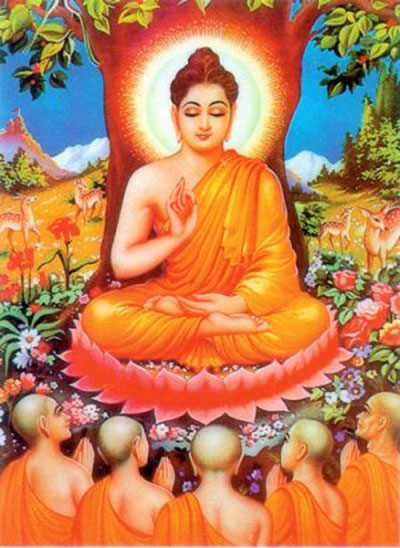
Siddhartha Gautama, the Buddha, had many legends and stories that had accreted around his life. While we can't be sure that any of these stories and legends are true and any of thousands of sayings attributed to him were actually said by him, we do know that the basic historical outlines of his life are accurate.
He was the chief's son of a tribal group, the Shakyas, so he was born a Kshatriya around 566 BC. At the age of twenty-nine, he left his family in order to lead an ascetic life. A few years later he reappears with a number of followers; he and his followers devote their lives to "The Middle Way," a lifestyle that is midway between a completely ascetic lifestyle and one that is world-devoted. At some point he gained "enlightenment" and began to preach this new philosophy in the region of Bihar and Uttar Kadesh. His teaching lasted for several decades and he perished at a very old age, somewhere in his eighties. Following his death, only a small group of followers continued in his footsteps. Calling themselves bhikkus , or "disciples," they wandered the countryside in yellow robes (in order to indicate their bhakti , or "devotion" to the master). For almost two hundred years, these followers of Buddha were a small, relatively inconsequential group among an infinite variety of Hindu sects. But when the great Mauryan emperor, Asoka, converted to Buddhism in the third century BC, the young, inconsequential religion spread like wildfire throughout India and beyond. Most significantly, the religion was carried across the Indian Ocean (a short distance, actually) to Sri Lanka. The Buddhists of Sri Lanka maintained the original form of Siddhartha's teachings, or at least, they maintained a form that was most similar to the original. While in the rest of India, and later the world, Buddhism fragmented into a million sects, the original form, called Theravada Buddhism, held its ground in Sri Lanka.
That's all we know about the historical life of Siddhartha, his mission, and the fate of his teachings. When we move into the Buddhist histories, the record becomes much more uncertain, particularly since the events of the Buddha's life vary from sect to sect.

What follows, however, is the most common outline of the nature of Siddhartha's life and philosophy. When Siddhartha Gautama was born, a seer predicted that he would either become a great king or he would save humanity. Fearing that his son would not follow in his footsteps, his father raised Siddhartha in a wealthy and pleasure-filled palace in order to shield his son from any experience of human misery or suffering. This, however, was a futile project, and when Siddhartha saw four sights: a sick man, a poor man, a beggar, and a corpse, he was filled with infinite sorrow for the suffering that humanity has to undergo.
After seeing these four things, Siddhartha then dedicated himself to finding a way to end human suffering. He abandoned his former way of life, including his wife and family, and dedicated himself to a life of extreme asceticism. So harsh was this way of life that he grew thin enough that he could feel his hands if he placed one on the small of his back and the other on his stomach. In this state of wretched concentration, in heroic but futile self-denial, he overheard a teacher speaking of music. If the strings on the instrument are set too tight, then the instrument will not play harmoniously. If the strings are set too loose, the instrument will not produce music. Only the middle way, not too tight and not too loose, will produce harmonious music. This chance conversation changed his life overnight. The goal was not to live a completely worldly life, nor was it to live a life in complete denial of the physical body, but to live in a Middle Way. The way out of suffering was through concentration, and since the mind was connected to the body, denying the body would hamper concentration, just as overindulgence would distract one from concentration.
With this insight, Siddhartha began a program of intense yogic meditation beneath a pipal tree in Benares. At the end of this program, in a single night, Siddhartha came to understand all his previous lives and the entirety of the cycle of birth and rebirth, or samsara, and most importantly, figured out how to end the cycle of infinite sorrow. At this point, Siddhartha became the Buddha.